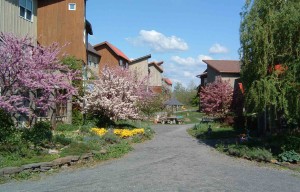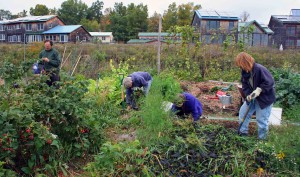Liz Walker, co-founder and executive director of EcoVillage at Ithaca, is sure to see familiar faces when walking on the pathways around the 175-acre ecovillage near Ithaca, N.Y. This morning, she walked to purchase bulk tofu because she is planning to make “Liz’s Famous Fried Tofu” for the community party this evening.
EcoVillage at Ithaca is just one example of a growing trend in the U.S. and around the world. People attracted not only to the idea of living an environmentally friendly lifestyle, but also to the sense of belonging found in a tight-knit community, often reside in these self-sustaining neighborhoods. Most ecovillages offer sustainable housing, the use of renewable energy and local food production.
There are more than 100 ecovillages in the U.S. But these communities can be found worldwide, with more than 450 listed in the Western Hemisphere alone.

A lane in the Frog ("First Residents Group") neighborhood at EcoVillage at Ithaca. Photo: EcoVillage at Ithaca

A lane in the Frog ("First Residents Group") neighborhood at EcoVillage at Ithaca. Photo: EcoVillage at Ithaca
What is an Ecovillage?
Every ecovillage is different. Classification, level of integration, size and location all give each its own character, style and meaning.
In 1991, Robert Gilman created a definition that has been adopted by many as the standard definition of an “ecovillage.” He said an ecovillage must be “a human-scale, full-featured settlement in which human activities are harmlessly integrated into the natural world in a way that is supportive of healthy human development, and can be successfully continued into the indefinite future.” More recently, Gilman has also added “multiple centers of initiative” to his definition.
Simply put, an ecovillage should resemble a “regular” community, but have a stronger focus on sustainability. It must be able to provide for its residents, but doesn’t necessarily have to be self-sustaining. Essentially, it is a microcosm of society, generally with populations of between 50 and 200 residents.
Classifications of ecovillages make it easier to differentiate between them:
- Intentional communities – An intentional community employs teamwork, shares resources and may hold a common social, religious, political or spiritual belief.
- Cohousing – Cohabitation, or cohousing, is another type of community. According to Walker, cohabitation is a community-oriented form of housing. Residents own their own home, but they are built in an extremely close-knit setting.
The EcoVillage at Ithaca is built into two cohousing neighborhoods, with a third on the way. Each neighborhood has 15 duplexes, or 30 families. There is also a common house found in each neighborhood.
“You take the cars out of the street to make it a pedestrian walkway. It’s almost like living around a park. There are gardens, ponds and picnic tables. You really get to see your neighbors,” Walker said.
While EcoVillage at Ithaca provides separate homes for each family, Twin Oaks in Virginia has private rooms for each resident, but shared kitchen, bathroom and living facilities.
Common houses are customary structures, bringing the community together for social events, meals and meetings.
Not Just for Country Life
While ecovillages are most frequently thought of as rural communities, urban ecovillages are also springing up around the world. One block from Vermont Avenue, one of the most congested traffic corridors in Los Angeles, you can find the Los Angeles Ecovillage.
Since 1993, the two-block community in the middle of urban sprawl allows its approximately 55 residents to live a more sustainable lifestyle in an environment where it is typically fairly difficult.

Residents work in the Song neighborhood community garden at EcoVillage at Ithaca. They feed more than 1,000 people each week off of 10 acres of land. Photo: EcoVillage at Ithaca

Residents work in the Song neighborhood community garden at EcoVillage at Ithaca. They feed more than 1,000 people each week off of 10 acres of land. Photo: EcoVillage at Ithaca
Living a Sustainable Lifestyle
Ecovillages employ many different techniques to lessen their environmental impact. One of the most significant is simply sharing. When energy, food and other resources are shared between many people, significantly less is used.
Thomas Vecchio, the visitor correspondent at Acorn community in Virginia notes that residents share utilities, Internet access and cars. Vecchio estimates their use is between 50 and 60 percent lower than that of the average consumer.
Most ecovillages utilize renewable energy, composting, recycling and food production. However, the specifics vary in each community. For example, the Los Angeles Ecovillage offers rent reductions for car-free residents.
Housing: According to their Web site, Ecovillage at Ithaca uses green building approaches such as passive solar design, photovoltaics, solar hot water, high-efficiency condensing gas boilers, super-insulated roofs, several types of high-performance windows, straw bale insulation, rainwater collection, composting toilets, drain heat recovery and salvaged materials.
Food: Most ecovillages grow much of their own food. The Los Angeles Ecovillage has a 7,000 square foot garden in which they grow fruit and vegetables. Residents of Dancing Rabbit, an ecovillage in Missouri, grow most of their own vegetables and herbs in their gardens.
EcoVillage at Ithaca has on-site organic farms. West Haven Farm markets its produce to the Ithaca Farmer’s Market and through its Community Supported Agriculture (CSA) program. They feed more than 1,000 people each week off of 10 acres of land.
Volunteering: Community work, such as chores, is often done on a voluntary basis. It may be used for maintenance, outdoor work, business and finances, or other tasks.
Twin Oaks ecovillage uses a labor-credit system where one hour of work serves as the basic unit of value, taking the place of the dollar.
To enjoy the fresh, organic food, ecovillages have community meals. They may be as frequent as 3 times each day, or just once each week. Typically, residents can volunteer to cook, serve and clean up after the meal.
A Strong Sense of Community
According to Vecchio, one of the greatest benefits of living in an ecovillage is the sense of community. “There is nothing like the social environment when you’re living with a group, working together, working out problems together. It’s like an extended family.”
Walker agrees. She enjoys the daily interaction with her neighbors, whether it’s working at the farms, taking out the compost or doing community laundry.
There’s also a great deal of diversity found in ecovillages. Both young and old, families and individual residents are welcome.
From organic farmers and environmental educators, to writers, computer software professionals, office attorneys and therapists, Walker says there is a wide variety of backgrounds among the residents and they all have something different to contribute.
Additionally, decisions in many ecovillages are made by consensus.
Having an Effect on the World
“We’re not tackling one issue, we’re trying to complete a paradigm shift. We’re trying to do that by supporting each other and creating community while learning how to ratchet down resource use,” said Walker.
She sees a great deal of value in the educational aspect of ecovillages. She believes they provide a model for others to learn different ways to live more a more eco-conscious lifestyle.
“What we’re finding is that so often people come here and they’re just kind of flabbergasted that such a place exists. It gives them a sense of inspiration and hope, which is exactly why we created this place. They don’t get it until they live and breathe it, when they actually see another way of living is possible,” said Walker.
Not quite ready to relocate to an ecovillage? Consider making your neighborhood into an ad-hoc ecovillage like Phinney Ridge in Seattle, Wash., where members hold regular meetings to help one another live in a more environmentally sustainable way. Support and tips from neighbors may make it easier to remember to turn off appliances while not in use and to keep the thermostat low.
Heeding the advice of ecovillages around the world, it is much easier to make lifestyle changes when you have a close community of people alongside you.

Lauren Hasler
Lauren is a journalism major at the University of Missouri with an interest in environmental sustainability education.